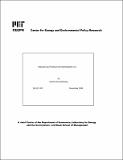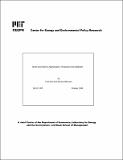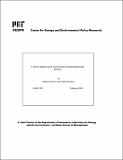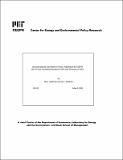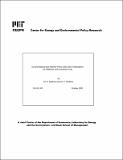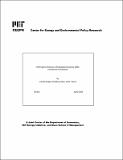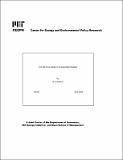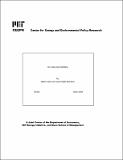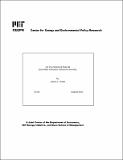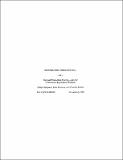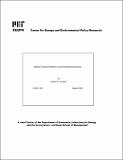Browsing Working Papers by Title
Now showing items 188-207 of 334
-
Natural gas pricing in the Northeastern U.S.
(MIT Center for Energy and Environmental Policy Research, 1998)This paper examines natural gas pricing at five citygate locations in the northeastern United States using daily and weekly price series for the years 1994-97. In particular, the effects of the natural gas price at Henry ... -
New entrant and closure provisions : how do they distort?
(MIT Center for Energy and Environmental Policy Research, 2006)As a person whose life began in England and ended in North America and who maintained academic affiliations in the United Kingdom, Canada and the U.S., Campbell Watkins had a fine appreciation for the subtle differences ... -
A new era for oil prices
(MIT Center for Energy and Environmental Policy Research, 2006)Since 2003 the international oil market has been moving away from the previous 20-year equilibrium in which prices fluctuated around $25/bbl (in today's dollars). The single most important reason is that growing demand has ... -
The new option view of investment
(MIT Center for Energy and Environmental Policy Research, 1995)This paper provides a simple introduction to the new option view of investment. We explain the shortcomings of the orthodox theory, and then outline the basic ideas behind the option framework. Several industry examples ... -
Nonparametric estimation of exact consumers surplus and deadweight loss
(MIT Center for Energy and Environmental Policy Research, 1993)We apply nonparametric regression models to estimation of demand curves of the type most often used in applied research. From the demand curve estimators we derive estimates of exact consumers surplus and deadweight loss, ... -
Nordic electricity congestion's arrangement as a model for Europe : physical constraints or operators' opportunism?
(MIT Center for Energy and Environmental Policy Research, 2002)Congestion on power grids seems a physical reality, a "hard" fact easy to check. Our paper models a different idea: congestion signal may be distorted by transmission system operators (TSOs), which puts the European ... -
North Sea reserve appreciation, production, and depletion
(MIT Center for Energy and Environmental Policy Research, 1999)Oil field "growth" has become a well-recognized phenomenon in mature, well-explored provinces such as the United States leading to the continual under-estimation in oil production forecasts. This working paper explores the ... -
A note on competitive investment under uncertainty
(MIT Center for Energy and Environmental Policy Research, 1991)This paper clarifies how uncertainty affects irreversible investment in a competitive market equilibrium. With free entry, irreversibility affects the distribution of future prices, and thereby creates an opportunity cost ... -
A note on market power in an emission permits market with banking
(MIT Center for Energy and Environmental Policy Research, 2004)In this paper, we investigate the effect of market power on the equilibrium path of an emission permits market in which firms can bank current permits for use in later periods. In particular, we study the market equilibrium ... -
Nuclear Fuel Recycling - the Value of the Separated Transuranics and the Levelized Cost of Electricity
(MIT Center for Energy and Environmental Policy Research, 2009-09)We analyze the levelized cost of electricity (LCOE) for three different fuel cycles: a Once-Through Cycle, in which the spent fuel is sent for disposal after one use in a reactor, a Twice-Through Cycle, in which the spent ... -
Oil and natural gas reserve prices : addendum to CEEPR WP 03-016 ; including results for 2003 revisions to 2001
(MIT Center for Energy and Environmental Policy Research, 2005)Introduction. A working paper entitled "Oil and Natural Gas Reserve Prices 1982-2002: Implications for Depletion and Investment Cost" was published in October 2003 (cited hereafter as Adelman & Watkins [2003]). Since then ... -
Oil and natural gas reserve prices, 1982-2002 : implications for depletion and investment cost
(MIT Center for Energy and Environmental Policy Research, 2003)A time series is estimated of in-ground prices - as distinct from wellhead prices ₆ of US oil and natural gas reserves for the period 1982-2002, using market purchase and sale transaction information. The prices are a ... -
Oil futures prices in a production economy with investment constraints
(MIT Center for Energy and Environmental Policy Research, 2008)We document a new stylized fact regarding the term structure of futures volatility. We show that the relationship between the volatility of futures prices and the slope of the term structure of prices is non-monotone and ... -
The oil price really is a speculative bubble
(MIT Center for Energy and Environmental Policy Research, 2008)The oil price really is a speculative bubble. Yet only recently has the U.S. Congress, for example, showed recognition that this might even be a possibility. In general there seems to be a preference for the claim that the ... -
On Coase and Hotelling
(2009)It has been long recognized that an exhaustible-resource monopsonist faces a commitment problem similar to that of a durable-good monopolist. Indeed, Hörner and Kamien (2004) demonstrate that the two problems are formally ... -
On The Portents of Peak Oil (And Other Indicators of Resource Scarcity)
(MIT Center for Energy and Environmental Policy Research, 2010-08)Although economists have studied various indicators of resource scarcity (e.g., unit cost, resource rent, and market price), the phenomenon of “peaking” has largely been ignored due to its connection to non-economic theories ... -
One for you, three for me, or, optimal production sharing rules for a petroleum exploration venture
(MIT Center for Energy and Environmental Policy Research, 1990)This is a case study in the design of the production sharing rule used in an oil exploration partnership contract. The contract was negotiated in mid-1986 when a state-owned oil resources authority hired a ... -
OPEC at high noon 1974-1981
(MIT Center for Energy and Environmental Policy Research, 1992)After 1973, oil consumption stagnated worldwide. Non-OPEC output increased, mostly in Alaska, Mexico, and the North Sea, but not because of the price rise. The cartel nations had to assume the whole burden of cutting back ... -
Optimal design of a phase-in emissions trading program with voluntary compliance options
(MIT Center for Energy and Environmental Policy Research, 1997.)In this paper we explore the welfare implications of voluntary compliance within an emissions trading program and derive optimal permits allocations to affected and opti-in sources when the environmental regulator has ... -
Optimal timing problems in environmental economics
(MIT Center for Energy and Environmental Policy Research, 2001)Because of the uncertainties and irreversibilities that are often inherent in environmental degradation, its prevention, and its economic consequences, environmental policy design can involve important problems of timing. ...

